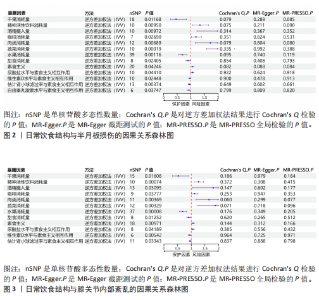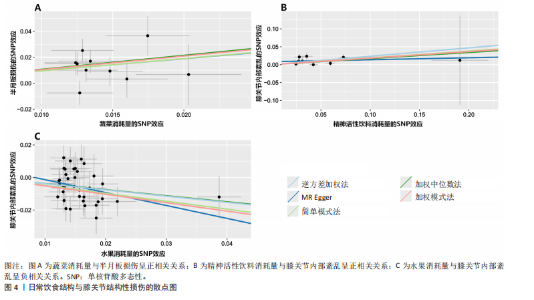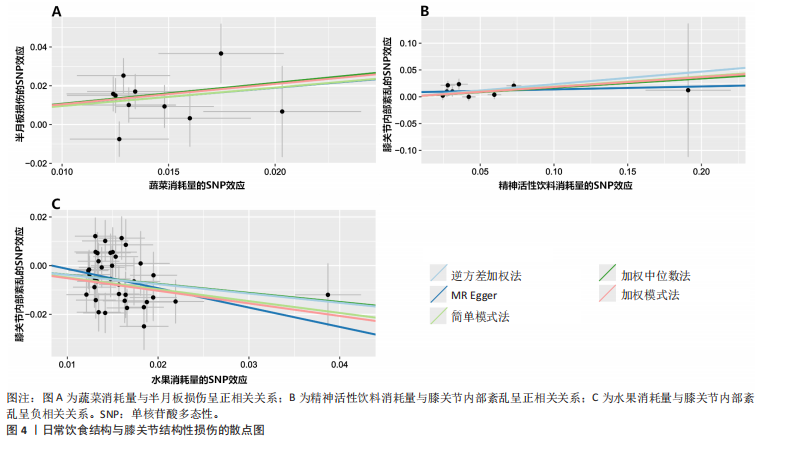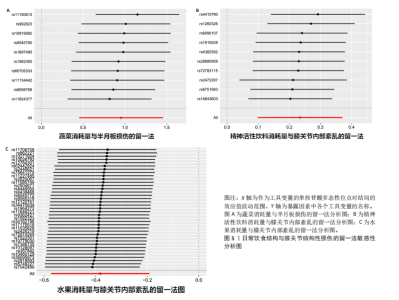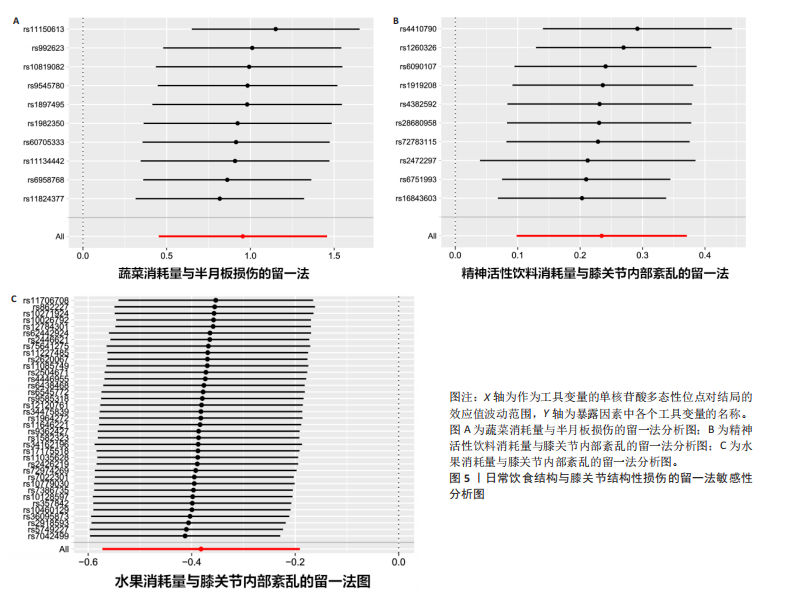Chinese Journal of Tissue Engineering Research ›› 2026, Vol. 30 ›› Issue (11): 2877-2885.doi: 10.12307/2026.094
Previous Articles Next Articles
Daily diet and structural damage of the knee joint: a large-scale genetic analysis based on UK and FinnGen databases
Yan Wenjian1, Li Yinghui2, Zhang Yong3
- 1China Basketball College, Beijing Sport University, Beijing 100084, China; 2College of Biomedical Engineering, Capital Medical University, Beijing 100069, China; 3Chinese Basketball Association, Beijing 100062, China
-
Received:2025-04-22Accepted:2025-06-11Online:2026-04-18Published:2025-09-06 -
Contact:Zhang Yong, PhD, Researcher, Chinese Basketball Association, Beijing 100062, China -
About author:Yan Wenjian, MS candidate, China Basketball College, Beijing Sport University, Beijing 100084, China
CLC Number:
Cite this article
Yan Wenjian, Li Yinghui, Zhang Yong. Daily diet and structural damage of the knee joint: a large-scale genetic analysis based on UK and FinnGen databases[J]. Chinese Journal of Tissue Engineering Research, 2026, 30(11): 2877-2885.
share this article
Add to citation manager EndNote|Reference Manager|ProCite|BibTeX|RefWorks
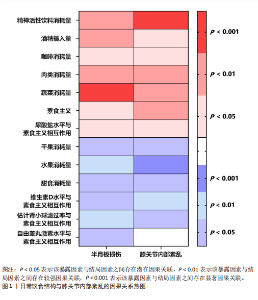
2.1 工具变量筛选结果 研究基于孟德尔随机化分析的核心假设,系统考虑了遗传变异的显著性关联、连锁不平衡控制、工具变量强度评估(F值 > 10),以及工具变量与混杂因素及结果变量的独立性等要求,对20种饮食结构中各暴露因素进行了系统性的工具变量筛选,分别构建了适用于半月板损伤与膝关节内部紊乱2个结局变量的遗传工具变量集合。共有17种暴露因素成功筛选出符合条件的工具变量,其中针对半月板损伤的分析,所保留的单核苷酸多态性数量范围为6-39个,针对膝关节内部紊乱的分析,所保留的单核苷酸多态性数量为5-37个,2个分析中所有工具变量的F统计量均> 10,符合强工具变量标准,表明两组结果均未受到弱工具变量偏倚的显著影响。值得注意的是,奶酪消耗量、沙拉消耗量和添加盐摄入量这3项暴露因素在筛选过程中均未能保留满足条件的工具变量,原因在于其相关遗传变异的F统计量均< 10,表明这些遗传变异与暴露因素间相关性不足,无法构成有效的强工具变量。若将弱工具变量纳入分析,可能导致因果效应估计的显著偏倚,得出错误的因果推断。因此,为确保分析结果的稳健性和科学性,研究未将上述3项暴露因素纳入后续的孟德尔随机化分析。 2.2 孟德尔随机化分析结果 逆方差加权法结果显示,与结果因素存在潜在因果关联的13种饮食结构中,7种饮食结构与半月板损伤呈正相关,6种饮食结构与半月板损伤呈负相关,7种饮食结构与膝关节内部紊乱呈正相关,5种饮食结构与膝关节内部紊乱呈负相关,见图1-3。蔬菜消耗量(OR=2.59,95%CI:1.57-4.29,P < 0.001)与半月板损伤风险增加存在显著因果关联,这一结果提示,虽然蔬菜富含多种营养素,但若摄入过量,大量的草酸和植酸会干扰人体对钙、锌等矿物质的吸收,导致肌肉力量下降和软组织修复受限,从而削弱膝关节的稳定性与缓冲能力,进而增加半月板结构损伤的风险。精神活性饮料(OR=1.26,95%CI:1.10-1.45,P < 0.001) 与膝关节内部紊乱风险增加存在显著因果关联,可能与高糖成分促进高级糖化终产物沉积,以及咖啡因诱导钙流失有关,两者共同对关节内部结构造成不利影响。水果消耗量(OR=0.68,95%CI:0.56-0.82,P < 0.001) 与膝关节内部紊乱风险降低存在显著因果关联,其保护作用可能来源于水果中丰富的天然抗氧化成分(如黄酮、多酚、维生素C),这些物质可有效缓解氧化应激与炎症反应,维持软骨和滑膜组织的结构稳定性。此外,为增强因果推断结果的稳健性,文章还采用MR-Egger回归、加权中位数法、简单模式法和加权模式法4种方法对逆方差加权法分析结果进行了补充验证。结果显示,以上4种方法所得效应估计方向与逆方差加权法一致,进一步支持了研究结论的可靠性,见图4。 2.3 敏感性分析结果 利用Cochran’s Q法进行异质性检验,结果显示,13种饮食结构与半月板损伤的工具变量之间不存在异质性(P > 0.05),12种饮食结构与膝关节内部紊乱的工具变量之间不存在异质性,见图2,3。MR-Egger截距测试和MR-PRESSO全局检验两种方法的结果显示,所有因果关系的工具变量之间不存在水平多效性(P > 0.05)。留一法分析显示,即便去除某个特定的单核苷酸多态性,整体因果效应估计并没有显著变化,没有单一单核苷酸多态性驱动整个效应,见图5。敏感性分析显示,研究的结果具有稳健型和可靠性。"
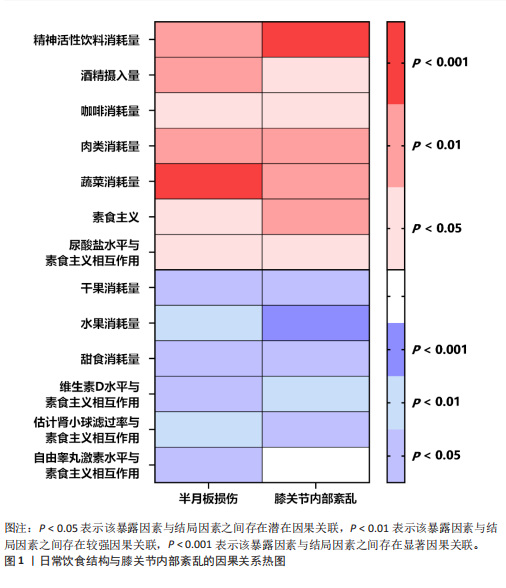
| [1] MEZHOV V, TEICHTAHL AJ, STRASSER R, et al. Meniscal pathology - the evidence for treatment. Arthritis Res Ther. 2014;16(2): 206. [2] PALMOWSKI Y, JUNG T, DOERING AK, et al. Analysis of cartilage injury patterns and risk factors for knee joint damage in patients with primary lateral patella dislocations. PLoS One. 2021;16(10):e0258240. [3] HEUTS EAF, DE JONG LD, HAZEBROEK EJ, et al. The influence of bariatric surgery on hip and knee joint pain: a systematic review. Surg Obes Relat Dis. 2021;17(9):1637-1653. [4] YAMAMOTO Y, MURATA Y, TANAKA N, et al. Mobile application for home exercise adherence in patients with knee osteoarthritis: A pilot study. Medicine (Baltimore). 2022;101(42):e31181. [5] DUONG V, OO WM, DING C, et al. Evaluation and Treatment of Knee Pain: A Review. JAMA. 2023;330(16):1568-1580. [6] HUFFMAN KF, AMBROSE KR, NELSON AE, et al. The Critical Role of Physical Activity and Weight Management in Knee and Hip Osteoarthritis: A Narrative Review. J Rheumatol. 2024;51(3):224-233. [7] IDOWU BM, AFOLABI BI, ONIGBINDE SO, et al. Magnetic Resonance Imaging of Internal Derangements and Other Knee Pathologies in Adult Nigerians. Niger Med J. 2023;64(4):569-581. [8] MA C, SEARLE D, TIAN J, et al. Dietary Inflammatory Index and Magnetic Resonance Imaging-Detected Knee Structural Change and Pain: A 10.7-Year Follow-up Study. Arthritis Care Res (Hoboken). 2024;76(6):813-820. [9] EMDIN CA, KHERA AV, KATHIRESAN S. Mendelian Randomization. JAMA. 2017; 318(19):1925-1926. [10] LAWLOR DA, HARBORD RM, STERNE JA, et al. Mendelian randomization: using genes as instruments for making causal inferences in epidemiology. Stat Med. 2008;27(8):1133-1163. [11] SPIGA F, GIBSON M, DAWSON S, et al. Tools for assessing quality and risk of bias in Mendelian randomization studies: a systematic review. Int J Epidemiol. 2023; 52(1):227-249. [12] DIDELEZ V, SHEEHAN N. Mendelian randomization as an instrumental variable approach to causal inference. Stat Methods Med Res. 2007;16(4):309-330. [13] KURKI MI, KARJALAINEN J, PALTA P, et al. FinnGen provides genetic insights from a well-phenotyped isolated population. Nature. 2023;613(7944):508-518. [14] 王晶,张国燕,程杉孟德尔随机化的良好实践:孟德尔随机化分析的常见设计、关键挑战及优化[J].首都医科大学学报, 2023,44(6):1087-1094. [15] SANNA S, VAN ZUYDAM NR, MAHAJAN A, et al. Causal relationships among the gut microbiome, short-chain fatty acids and metabolic diseases. Nat Genet. 2019; 51(4):600-605. [16] BURGESS S, BUTTERWORTH A, THOMPSON SG. Mendelian randomization analysis with multiple genetic variants using summarized data. Genet Epidemiol. 2013;37(7):658-665. [17] XIANG K, WANG P, XU Z, et al. Causal Effects of Gut Microbiome on Systemic Lupus Erythematosus: A Two-Sample Mendelian Randomization Study. Front Immunol. 2021; 12:667097. [18] BOWDEN J, DAVEY SMITH G, et al. Mendelian randomization with invalid instruments: effect estimation and bias detection through Egger regression. Int J Epidemiol. 2015;44(2):512-525. [19] BOWDEN J, DAVEY SMITH G, et al. Consistent Estimation in Mendelian Randomization with Some Invalid Instruments Using a Weighted Median Estimator. Genet Epidemiol. 2016;40(4):304-314. [20] GRECO M FD, MINELLI C, SHEEHAN NA, et al. Detecting pleiotropy in Mendelian randomisation studies with summary data and a continuous outcome. Stat Med. 2015; 34(21):2926-2940. [21] BURGESS S, DAVEY SMITH G, DAVIES NM, et al. Guidelines for performing Mendelian randomization investigations: update for summer 2023. Wellcome Open Res. 2023;4:186. [22] PETROSKI W, MINICH DM. Is There Such a Thing as “Anti-Nutrients”? A Narrative Review of Perceived Problematic Plant Compounds. Nutrients. 2020;12(10):2929. [23] AKTER S, NETZEL M, TINGGI U, et al. Interactions Between Phytochemicals and Minerals in Terminalia ferdinandiana and Implications for Mineral Bioavailability. Front Nutr. 2020;7:598219. [24] ZHANG YY, STOCKMANN R, NG K, et al. Revisiting phytate-element interactions: implications for iron, zinc and calcium bioavailability, with emphasis on legumes. Crit Rev Food Sci Nutr. 2022;62(6):1696-1712. [25] TERRELL K, CHOI S, CHOI S. Calcium’s Role and Signaling in Aging Muscle, Cellular Senescence, and Mineral Interactions. Int J Mol Sci. 2023;24(23):17034. [26] LI M, NIE Y, LI K, et al. Effect of Extensor Muscle Strength on Meniscus Damage Progression in Subjects Without Radiologic Knee Osteoarthritis: Data From the Osteoarthritis Initiative. Am J Phys Med Rehabil. 2022;101(9):836-842. [27] COSTA MI, SARMENTO-RIBEIRO AB, GONÇALVES AC. Zinc: From Biological Functions to Therapeutic Potential. Int J Mol Sci. 2023;24(5):4822. [28] LI Q, WEN Y, WANG L, et al. Hyperglycemia-induced accumulation of advanced glycosylation end products in fibroblast-like synoviocytes promotes knee osteoarthritis. Exp Mol Med. 2021; 53(11):1735-1747. [29] GOULDIN AG, PATEL NK, GOLLADAY GJ, et al. Advanced glycation end-product accumulation differs by location and sex in aged osteoarthritic human menisci. Osteoarthritis Cartilage. 2023;31(3):363-373. [30] BERMAN NK, HONIG S, CRONSTEIN BN, et al. The effects of caffeine on bone mineral density and fracture risk. Osteoporos Int. 2022;33(6):1235-1241. [31] CHEN B, HE Q, CHEN C, et al. Combination of curcumin and catalase protects against chondrocyte injury and knee osteoarthritis progression by suppressing oxidative stress. Biomed Pharmacother. 2023;168:115751. [32] NEJADHOSSEINIAN M, DJALALINIA S, HAERIAN H, et al. The effects of antioxidants on knee osteoarthritis: A systematic review and meta-analysis. Front Nutr. 2022;9: 1026450. [33] LU W, SHI Y, WANG R, et al. Antioxidant Activity and Healthy Benefits of Natural Pigments in Fruits: A Review. Int J Mol Sci. 2021;22(9):4945. [34] THALER R, KHANI F, STURMLECHNER I, et al. Vitamin C epigenetically controls osteogenesis and bone mineralization. Nat Commun. 2022;13(1):5883. [35] LIS DM, JORDAN M, LIPUMA T, et al. Collagen and Vitamin C Supplementation Increases Lower Limb Rate of Force Development. Int J Sport Nutr Exerc Metab. 2022;32(2):65-73. [36] GO DJ, KIM DH, KIM JY, et al. Serum uric acid and knee osteoarthritis in community residents without gout: a longitudinal study. Rheumatology (Oxford). 2021;60(10):4581-4590. [37] WANG R, WANG ZM, XIANG SC, et al. Relationship between 25-hydroxy vitamin D and knee osteoarthritis: a systematic review and meta-analysis of randomized controlled trials. Front Med (Lausanne). 2023;10:1200592. [38] JOSEPH GB, MCCULLOCH CE, NEVITT MC, et al. Associations Between Vitamins C and D Intake and Cartilage Composition and Knee Joint Morphology Over 4 Years: Data From the Osteoarthritis Initiative. Arthritis Care Res (Hoboken). 2020;72(9):1239-1247. [39] PARK TY, CHOI MY, KONG D, et al. Do Strength and Anthropometric Size of the Lower Body Correlate with Serum Testosterone Levels? World J Mens Health. 2025;43(1):205-212. [40] MANZO-AVALOS S, SAAVEDRA-MOLINA A. Cellular and mitochondrial effects of alcohol consumption. Int J Environ Res Public Health. 2010;7(12):4281-4304. [41] ZHU D, WANG X, XI Z, et al. Diet influences knee osteoarthritis osteophyte formation via gut microbiota and serum metabolites. iScience. 2024;27(6):110111. [42] TURNBULL J, JHA RR, BARRETT DA, et al. The Effect of Acute Knee Injuries and Related Knee Surgery on Serum Levels of Pro- and Anti-inflammatory Lipid Mediators and Their Associations With Knee Symptoms. Am J Sports Med. 2024;52(4):987-997. [43] FORTIER LA, BARKER JU, STRAUSS EJ, et al. The role of growth factors in cartilage repair. Clin Orthop Relat Res. 2011;469(10):2706-2715. |
| [1] | Liu Fengzhi, Dong Yuna, Tian Wenyi, Wang Chunlei, Liang Xiaodong, Bao Lin. Gene-predicted associations between 731 immune cell phenotypes and rheumatoid arthritis [J]. Chinese Journal of Tissue Engineering Research, 2026, 30(5): 1311-1319. |
| [2] | Ding Yu, Chen Jingwen, Chen Xiuyan, Shi Huimin, Yang Yudie, Zhou Meiqi, Cui Shuai, . Circulating inflammatory proteins and myocardial hypertrophy: large sample analysis of European populations from GWAS Catalog and FinnGen databases [J]. Chinese Journal of Tissue Engineering Research, 2026, 30(4): 1047-1057. |
| [3] | Liu Chu, Qiu Boyuan, Tong Siwen, He Linyuwei, Chen Haobo, Ou Zhixue. A genetic perspective reveals the relationship between blood metabolites and osteonecrosis: an analysis of information from the FinnGen database in Finland [J]. Chinese Journal of Tissue Engineering Research, 2026, 30(3): 785-794. |
| [4] | Jiang Kai, Rong Yifa, Jia Haifeng, Li Hanzheng, Lu Bowen, Liang Xuezhen, Li Gang. Relationship between inflammatory factors and rheumatoid arthritis: a large-sample analysis based on the FinnGen R10 database and genome-wide association studies [J]. Chinese Journal of Tissue Engineering Research, 2026, 30(10): 2629-2640. |
| [5] | Dong Tingting, Chen Tianxin, Li Yan, Zhang Sheng, Zhang Lei. Causal relationship between modifiable factors and joint sports injuries [J]. Chinese Journal of Tissue Engineering Research, 2025, 29(9): 1953-1962. |
| [6] | Li Jiatong, Jin Yue, Liu Runjia, Song Bowen, Zhu Xiaoqian, Li Nianhu . Association between thyroid function levels and phenotypes associated with sarcopenia [J]. Chinese Journal of Tissue Engineering Research, 2025, 29(6): 1312-1320. |
| [7] | Wu Guangtao, Qin Gang, He Kaiyi, Fan Yidong, Li Weicai, Zhu Baogang, Cao Ying . Causal relationship between immune cells and knee osteoarthritis: a two-sample bi-directional Mendelian randomization analysis [J]. Chinese Journal of Tissue Engineering Research, 2025, 29(5): 1081-1090. |
| [8] | Wang Xuepeng, , He Yong, . Effect of insulin-like growth factor family member levels on inflammatory arthritis: a FinnGen biobank-based analysis [J]. Chinese Journal of Tissue Engineering Research, 2025, 29(35): 7656-7662. |
| [9] | Wu Zhenhua, Zhang Xiwei, Wang Yipin, Li Qianqian. Relationship between seven serum lipid traits and osteoarthritis: a large sample analysis of European population in IEU OPEN GWAS database [J]. Chinese Journal of Tissue Engineering Research, 2025, 29(32): 7004-7014. |
| [10] | Luo Weidong, Pu Bin, Gu Peng, Huang Feng, Zheng Xiaohui, Chen Fuhong. Mendelian randomization study on the association between telomere length and 10 common musculoskeletal diseases [J]. Chinese Journal of Tissue Engineering Research, 2025, 29(3): 654-660. |
| [11] | Chai Jinlian, Sun Tiefeng, Li Wei, Zhang Bochun, Li Guangzheng, Shao Xuekun, Wang Ping, Liang Xuezhen. Cathepsins and osteonecrosis: analysis based on European samples from the FinnGen Database and IEU OpenGWAS Database [J]. Chinese Journal of Tissue Engineering Research, 2025, 29(24): 5254-5262. |
| [12] | Peng Zehong, Zhu Xi, Wen Jianglong, Zhu Wenzhuo, Liu Chao, Tang Jianwei, Cao Ziyue, Zhu Lili. Causal relationship between 39 plasma coagulation factors and chronic kidney disease based on samples from the GWAS Catalog database [J]. Chinese Journal of Tissue Engineering Research, 2025, 29(24): 5272-5280. |
| [13] | Wang Zikun, Li Shudong, Gao Shuang, Fan Shuhao, Li Cheng, Meng Chunyang. Relationship between intervertebral disc degeneration and 473 gut microbiotas: what can be learned from big data information in the FinnGen database [J]. Chinese Journal of Tissue Engineering Research, 2025, 29(20): 4369-4378. |
| [14] | Huo Jiang, Ding Yu, Yuan Jie. Immune cells mediate the association between different lipids and knee osteoarthritis: a genome-wide association analysis of European individuals [J]. Chinese Journal of Tissue Engineering Research, 2025, 29(18): 3934-3940. |
| [15] | Fang Zhijie, Ma Qiangping, Dong Wantao, Wu Junyuan, Lu Yunlin. Genetic causal relationship between gut microbiota and osteoporosis: analysis of 211 gut microbiota from the UK database [J]. Chinese Journal of Tissue Engineering Research, 2025, 29(18): 3941-3947. |
| Viewed | ||||||
|
Full text |
|
|||||
|
Abstract |
|
|||||
